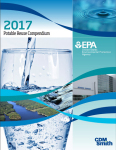2017 Potable Reuse Compendium

Environmental Protection Agency and CDM Smith, Inc., 2017
 The 2017 Potable Reuse Compendium provides a technical compilation of the current state of potable water reuse in the United States. It supplements the 2012 Guidelines for Water Reuse, which were developed to serve as an authoritative reference on water reuse practices. The compendium was created to assist planners and decision-makers considering potable reuse approaches by presenting the current state of practice in the United States. It covers multiple topics including the extent of potable water reuse in the United States and the world, treatment technologies and processes, the costs of potable water reuse, risk analysis, training and operating practices, and public acceptance. In addition, the compendium presents seven case studies, which describe the implementation of indirect and direct potable reuse in the United States. These cases include the Los Alamitos Barrier Water Replenishment District of Southern California-Leo J. Vander Lans Advanced Water Treatment Facility; Orange County Groundwater Replenishment System Advanced Water Treatment Facility; Gwinnett F. Wayne Hill Water Resources Center, Chattahoochee River and Lake Lanier Discharge; Village of Cloudcroft PURe Water Project; Colorado River Municipal Water District Raw Water Production Facility Big Spring Plant; Wichita Falls River Road WWTP and Cypress WTP Permanent Indirect Potable Reuse and Emergency Direct Potable Reuse Project; and Potable Water Reuse in the Occoquan Watershed.
The 2017 Potable Reuse Compendium provides a technical compilation of the current state of potable water reuse in the United States. It supplements the 2012 Guidelines for Water Reuse, which were developed to serve as an authoritative reference on water reuse practices. The compendium was created to assist planners and decision-makers considering potable reuse approaches by presenting the current state of practice in the United States. It covers multiple topics including the extent of potable water reuse in the United States and the world, treatment technologies and processes, the costs of potable water reuse, risk analysis, training and operating practices, and public acceptance. In addition, the compendium presents seven case studies, which describe the implementation of indirect and direct potable reuse in the United States. These cases include the Los Alamitos Barrier Water Replenishment District of Southern California-Leo J. Vander Lans Advanced Water Treatment Facility; Orange County Groundwater Replenishment System Advanced Water Treatment Facility; Gwinnett F. Wayne Hill Water Resources Center, Chattahoochee River and Lake Lanier Discharge; Village of Cloudcroft PURe Water Project; Colorado River Municipal Water District Raw Water Production Facility Big Spring Plant; Wichita Falls River Road WWTP and Cypress WTP Permanent Indirect Potable Reuse and Emergency Direct Potable Reuse Project; and Potable Water Reuse in the Occoquan Watershed.
Uncharted Waters: The New Economics of Water Scarcity and Variability
by Richard Damania, Sébastien Desbureaux, Marie Hyland, Asif Islam, Scott Moore, Aude-Sophie Rodella, Jason Russ, Esha Zaveri

The World Bank has released a report that examines the impacts of population growth and climate change on 21st century water supplies and how decreases in water availability and increased uncertainty will be felt across water use sectors. The report notes that family incomes, jobs, and long-term health and welfare will suffer long-term effects and that fundamental changes to water policy are needed. Because water has many economic attributes, a multi-pronged policy response will be needed to adequately address the threats. The report can be found at https://openknowledge.worldbank.org/handle/10986/28096
Public Supply and Domestic Water Use in the United States, 2015
By Cheryl A. Dieter and Molly A. Maupin

U.S. Geological Survey Open-File Report 2017–1131
 The USGS has been estimating U.S. water use every five years since 1950. The reports provide comprehensive data regarding public-supply use, including domestic water deliveries. The new report highlights reduced water withdrawals for domestic use. From 2010 to 2015, total population in the United States increased 4 percent, but total withdrawals for public supply decreased, continuing the decreasing trend observed between 2005 and 2010. On average across the country, there was an overall 3 percent decrease in domestic use from 2010 to 2015, resulting in a decrease of six gallons per capita per day. Go to https://pubs.er.usgs.gov/publication/ofr20171131 to access the report.
The USGS has been estimating U.S. water use every five years since 1950. The reports provide comprehensive data regarding public-supply use, including domestic water deliveries. The new report highlights reduced water withdrawals for domestic use. From 2010 to 2015, total population in the United States increased 4 percent, but total withdrawals for public supply decreased, continuing the decreasing trend observed between 2005 and 2010. On average across the country, there was an overall 3 percent decrease in domestic use from 2010 to 2015, resulting in a decrease of six gallons per capita per day. Go to https://pubs.er.usgs.gov/publication/ofr20171131 to access the report.

